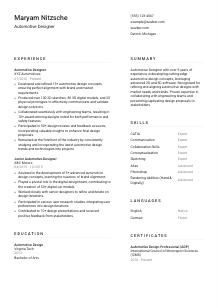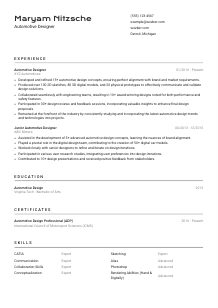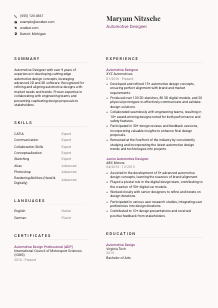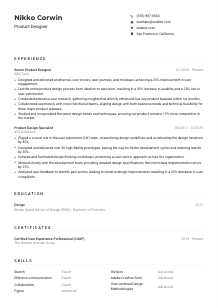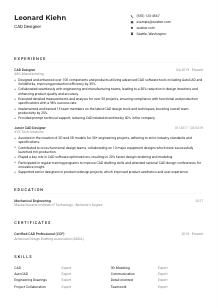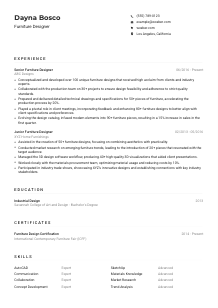Automotive Designer Resume Example
Revving up sketchpads, but feel stalled on your resume? Cruise through this Automotive Designer resume example, styled with Wozber free resume builder. See how effortlessly you can merge your vehicle visions with job aspirations, steering your career on a design-driven highway!
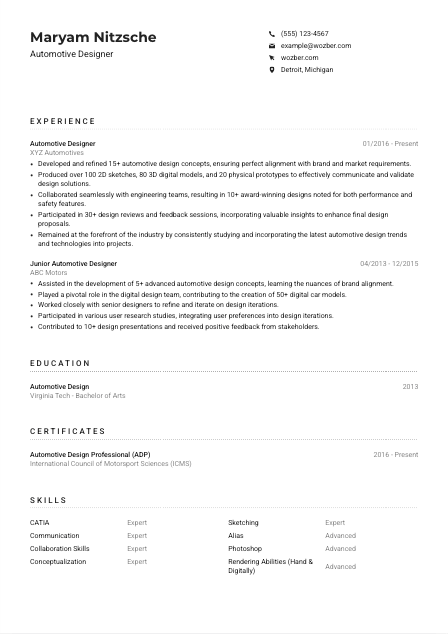
How to write an Automotive Designer Resume?
Hello, aspiring Automotive Designer trailblazer! In the realm of creativity fused with mechanical prowess, standing out from the crowd isn't just a goal; it's a necessity. Your resume is not merely a document—it's a portfolio, a blend of art and engineering, showcasing your quintessential skills and groundbreaking designs. Harnessing the power of Wozber's free resume builder, this guide is meticulously sculpted to guide you into crafting an ATS-compliant resume that not only speaks volumes about your proficiency but is also tailored exquisitely for your dream role.
Ready to turn the ignition on your career journey? Let's throttle ahead and sculpt your resume into a masterpiece that captivates and convinces.
Personal Details
First impressions are as crucial in job hunting as the first sketch in automotive design. Let's fine-tune your Personal Details section with precision, ensuring it pairs perfectly with your aspirations as an Automotive Designer.
1. Craft Your Name with Authority
Think of your name as the logo on a car—make it memorable. Opt for a font that's professional yet modern. Position it proudly at the top, like the emblem that radiates confidence.
2. Title It Right
Directly beneath your name, align your ambition with reality by stating your desired role: "Automotive Designer". This isn't just about stating your aspirations; it's about claiming your space in the design world.
3. Ensure Your Contact Info Drives Home
- Phone Number: Let this be the bridge that connects you with potential employers—ensure it's correct and professional.
- Professional Email Address: Your email address should echo your professionalism. A format following firstname.lastname@email.com is your best bet.
4. Location Matters
Just as a car needs to be tested on the streets of Detroit, show that you're in the heart of the automotive world by highlighting your Detroit, Michigan, location. It validates your familiarity with the automotive hub.
5. Digital Footprint
In today's digital age, a LinkedIn profile or a personal website showcasing your portfolio can be the digital showroom of your work. Ensure it's polished and mirrors the innovation and creativity in your resume.
Takeaway
Your Personal Details section is like the sleek hood of a car—underneath lies the engine of your career potential. Craft it with thoughtfulness and professionalism, ensuring it's perfectly aligned with the target role. It's your first opportunity to make a lasting impression. Let it reflect the best of you.





Experience
The roads you've traveled professionally highlight not only where you've been but also where your designs have left a mark. Let's navigate through how the Experience section for the Automotive Designer position was intricately woven to reflect the job requirements.
- Developed and refined 15+ automotive design concepts, ensuring perfect alignment with brand and market requirements.
- Produced over 100 2D sketches, 80 3D digital models, and 20 physical prototypes to effectively communicate and validate design solutions.
- Collaborated seamlessly with engineering teams, resulting in 10+ award‑winning designs noted for both performance and safety features.
- Participated in 30+ design reviews and feedback sessions, incorporating valuable insights to enhance final design proposals.
- Remained at the forefront of the industry by consistently studying and incorporating the latest automotive design trends and technologies into projects.
- Assisted in the development of 5+ advanced automotive design concepts, learning the nuances of brand alignment.
- Played a pivotal role in the digital design team, contributing to the creation of 50+ digital car models.
- Worked closely with senior designers to refine and iterate on design iterations.
- Participated in various user research studies, integrating user preferences into design iterations.
- Contributed to 10+ design presentations and received positive feedback from stakeholders.
1. Analyze the Design Blueprint
Initiate by dissecting the job description. Each responsibility and requirement is a cue for what to showcase in your experience. For an Automotive Designer, recognizing the emphasis on "developing and refining automotive design concepts" or "collaborating with engineering teams" is crucial.
2. Construct Your Career Roadmap
Lay out your journey in reverse chronological order. Highlight your role, the name of the firm, and the timeframe. This structure not only displays your career trajectory but also signals growth and progression.
3. Showcase Your Masterpieces
Each role you list is a gallery of your work. Detail out projects where you "Developed 15+ automotive design concepts", or "Collaborated seamlessly with engineering teams". This quantification of achievements not only demonstrates your capability but also your impact.
4. The Art of Numbers
In design, precision is key, and the same goes for your resume. Quantifying your contributions adds a layer of credibility and scale—"Produced over 100 2D sketches, 80 3D digital models, and 20 physical prototypes" speaks volumes of your expertise.
5. Tailor Your Palette
In the world of design, relevance is everything. Prioritize experiences that resonate with the job description. Extraneous details can distract from the core competencies sought by employers in an Automotive Designer.
Takeaway
Your Experience section is your professional narrative, illustrated through your achievements and roles. Tailor it with precision to reflect your journey's relevance and impact on the automotive design world. It's your opportunity to highlight why you're not just a fit but the perfect driver for the role ahead.
Education
The foundation of your designs starts with your education. Let's draft how the Education section of an Automotive Designer should be structured to mirror the craftsmanship and finesse required by the job.
1. Identify the Design Essentials
Zero in on what the job requires education-wise. Having a "Bachelor's degree in Automotive Design, Industrial Design, or a related field" is non-negotiable for an Automotive Designer role.
2. Craft Your Educational Path
Your education section should be clear and straightforward. List your degree, the field of study, where you studied, and your graduation year. This concise format helps hiring managers quickly verify your qualifications.
3. Align Your Credentials
"Bachelor of Arts in Automotive Design" not only satisfies the basic requirement but also signals a direct match with the industry. Make sure your degree aligns perfectly with the job listing to avoid any discrepancies.
4. Display Your Design Arsenal
Although not required for seasoned designers, if you're new to the field, showcasing relevant courses or projects can add depth to your profile, especially if they align closely with responsibilities mentioned in the job description.
5. Certifications and Extras
Beyond formal education, highlighting certifications like "Automotive Design Professional (ADP)" can set you apart. It signifies a commitment to your craft and continuous learning—an attractive trait in the fast-evolving automotive sector.
Takeaway
Your Education section is a testament to your foundational skills and knowledge in automotive design. By aligning it with the job's requirements, you prove not only your qualifications but your dedication to excellence in the field. Let it be a reflection of your professionalism and passion for automotive design.
Certificates
In a sphere where design and technology rapidly evolve, certifications are like the turbo boost for your resume. Here's how to strategically include them in your resume to cement your expertise further.
1. Scan the Design Specs
Start by revisiting the job description. Identify if any specific certifications are mentioned. While our Automotive Designer role didn't specify certifications, staying abreast with recognized ones in the field is advantageous.
2. Curate Your Certifications
Choose wisely. Highlight certifications that resonate with your professional narrative and the job at hand. 'Automotive Design Professional (ADP)' certification, for instance, underscores your specialized knowledge and dedication.
3. Time-stamp Your Achievements
Like models of cars, certifications have their eras of relevance. Mention the year of achievement to showcase how current your expertise is, making you a timely fit for the role.
4. Upgrade and Update
The design landscape is ever-changing; so should your credentials. Pursue ongoing education and update your certifications. It speaks to your commitment to staying at the forefront of automotive design innovations.
Takeaway
While not explicitly mentioned in every job description, certifications can turbocharge your resume, providing tangible proof of your expertise and commitment to ongoing professional development. Incorporate relevant certifications to showcase that your knowledge runs wide and deep, underscoring your value as an Automotive Designer.
Skills
The Skills section of your resume is your horsepower. It showcases the abilities that propel you forward in your career. For an Automotive Designer, striking a balance between creative and technical skills is key. Let's gear up to align it correctly.
1. Decipher the Blueprint
Kick off by highlighting skills expressly mentioned in the job listing. In our case, proficiencies in "design software like CATIA, Alias, and Photoshop" are explicitly sought after. This attention to detail signals your attentiveness to the role's specifics.
2. Showcase Your Design Toolkit
List both hard and soft skills that you possess which align directly with the job requirements. Skills in "Strong conceptualization, sketching, and rendering abilities" not only demonstrate your technical expertise but also your creative competency.
3. Organize for Impact
While it might be tempting to list every skill under the sun, prioritize those most relevant to the job at hand. An ATS-compliant resume recognizes and values succinctness; keep your list focused and impactful.
Takeaway
Your Skills section is a compact display of your professional capabilities. Fine-tune it to match the job requirements, illustrating that you're not just a candidate, but a perfectly engineered match for the role. This concise list of skills tells the hiring manager at a glance that you have exactly what it takes to drive success in their organization.
Languages
In the global marketplace of automotive design, the ability to communicate in multiple languages can be a significant lever. Here's how to turbocharge your resume with your linguistic prowess, enhancing your appeal as a globally aware designer.
1. Match the Job Requirement
The job posting indicates, "Must be fluent in English." That's your cue. List English at the top, and make sure your proficiency level is clearly stated. For this role, being "Native" or "Fluent" is crucial.
2. Leverage Additional Languages
Should you speak other languages, list them too. Even if not directly sought by the employer, additional languages can signify your versatility and global mindset—an attractive quality in the ever-international automotive industry.
3. Be Clear About Your Proficiency
Honesty is key. Clearly delineate your level of proficiency for each language using terms like "Native", "Fluent", "Intermediate", and "Basic". This clarity will help set accurate expectations.
4. Assess the Role's Global Scope
For positions with a global reach or for companies with a diverse team, the ability to communicate across cultures is invaluable. Even if a second language isn't required, it can undoubtedly enhance your candidacy.
5. Continuous Learning
Language is an art form—dynamic and ever-evolving. Showcasing your commitment to learning and improving language skills can add an extra layer of appeal, demonstrating your adaptability and eagerness to engage in diverse environments.
Takeaway
Your ability to communicate in different languages is more than just a line on a resume—it's a testament to your ability to navigate the global landscape of automotive design. By thoughtfully including your linguistic skills, you open doors to international opportunities, enriching your professional journey. Embrace your linguistic capabilities as integral gears in your design-driven career.
Summary
The Summary section is your pitch, the ignition of interest in your profile. Composing a compelling narrative that resonates with your career aspirations as an Automotive Designer is vital. Let's put your designs into words.
1. Capture the Job Essence
Start by absorbing the essence of the job posting. Reflect on key phrases like "developing and refining automotive design concepts" and "collaborating closely with engineering teams" to frame your opening statement.
2. Introduce Your Professional Self
Begin with a strong introduction that encapsulates your experience and specialties in automotive design. Highlight your years of experience to establish credibility right from the start.
3. Illustrate Your Skills and Achievements
List your most compelling skills and achievements that meet the job requirements. From "Developed 15+ automotive design concepts" to "Collaborated seamlessly with engineering teams"—showcase your value and impact.
4. Keep It Concise and Powerful
Remember, the Summary is your teaser trailer, not the feature film. Aim for 3-5 lines that are impactful, engrossing, and invite the reader to delve deeper into your resume. Let this section encapsulate who you are as an Automotive Designer.
Takeaway
Your Summary section is the steering wheel in your hands. It guides the hiring manager's first impression and directs their attention to your most impressive achievements. Tailored to mirror the job posting, it signals that you're not merely applying—you're answering the call. Make it compelling, make it memorable, and above all, make it unmistakably you.
Launching Your Automotive Design Odyssey
Congratulations on completing this detailed journey through each section of an ATS-friendly resume tailored for an Automotive Designer position! Armed with these insights and leveraging the power of Wozber's free resume builder, including the ATS-compliant resume formats and the ATS resume scanner, you're now equipped to craft a resume that doesn't just match the job—it propels you towards it. Remember, your resume is your career blueprint; refine it, showcase your unique design philosophy, and let it fuel your ascent in the automotive design universe.
The world is waiting to see where your designs will drive us next. Buckle up, it's time to hit the road to success!

- Bachelor's degree in Automotive Design, Industrial Design, or a related field.
- Minimum of 5 years of professional design experience, preferably in the automotive industry.
- Proficient with design software, including CATIA, Alias, and Photoshop.
- Strong conceptualization, sketching, and rendering abilities both by hand and digitally.
- Excellent communication and collaboration skills to work effectively in cross-functional teams.
- Must be fluent in English.
- Must be located in Detroit, Michigan.
- Develop and refine automotive design concepts, ensuring alignment with brand and market requirements.
- Produce 2D sketches, 3D digital models, and physical prototypes to communicate and validate design solutions.
- Collaborate closely with engineering teams to ensure design feasibility, performance, and safety.
- Participate in design reviews, feedback sessions, and present design proposals to stakeholders.
- Stay updated with the latest automotive design trends, technologies, and user preferences.





